Effects of Oil Contamination on Range of Soil Types in Middle Taiga of Western Siberia
Abstract
1. Introduction
2. Materials and Methods
2.1. Soil Collection and Characterization
2.2. Surfactant and Petroleum Investigations
2.3. Data Processing
3. Results
3.1. Effects of Oil on Physical–Chemestry Characteristics of Soil Samples
3.2. Effects of the Surfactant on the Total Amount of Oil in the Contaminated Soil Samples
4. Discussion
5. Conclusions
Author Contributions
Funding
Institutional Review Board Statement
Informed Consent Statement
Data Availability Statement
Acknowledgments
Conflicts of Interest
References
- Daryaee, R.; Moosavi, A.A.; Ghasemi, R.; Riazi, M. Chapter 13—Review of the Effects of Oil Pollutants on Physicochemical and Biological Soil Properties. In Biotechnology of Emerging Microbes; Sarma, H., Joshi, S.J., Eds.; Progress in Biochemistry and Biotechnology; Academic Press: Cambridge, MA, USA, 2024; pp. 263–297. ISBN 978-0-443-15397-6. [Google Scholar]
- Shah, G.; Soni, V. Comprehensive Insights into the Impact of Oil Pollution on the Environment. Reg. Stud. Mar. Sci. 2024, 74, 103516. [Google Scholar] [CrossRef]
- Pivovarova, I.I.; Makhovikov, A.B. Ecological regionalization methods of oil producing areas. J. Ecol. Eng. 2017, 18, 35–42. [Google Scholar] [CrossRef]
- Vasilyeva, G.K.; Strijakova, E.R.; Ortega-Calvo, J.J. Remediation of soils polluted by oil industries. In Soil Remediation Science and Technology, 1st ed.; Ortega-Calvo, J.J., Coulon, F., Eds.; Springer Nature: Cham, Switzerland, 2024; pp. 191–234. [Google Scholar] [CrossRef]
- Vodyanitskii, Y.N. Iron compounds and oil biodegradation in overmoistened contaminated soils: A review of publications. Eurasian Soil Sci. 2011, 44, 1250–1259. [Google Scholar] [CrossRef]
- He, G.; Tian, Z.; Liao, K.; Shi, J.; Wang, L. Numerical investigation on the migration of leaked pollutants after liquid pressurized pipeline leakage regarding oil and gas parallel pipelines situation. Process Saf. Environ. Prot. 2023, 177, 1–16. [Google Scholar] [CrossRef]
- Ministry of Natural Resources and Environment of the Russian Federation. 2022; Federal Report on the State of the Environment in the Russian Federation in 2022. Ministry of Natural Resources and Environment of the Russian Federation. Available online: https://www.mnr.gov.ru/docs/gosudarstvennye_doklady/gosudarstvennyy_doklad_o_sostoyanii_i_ob_okhrane_okruzhayushchey_sredy_rossiyskoy_federatsii_v_2022_/ (accessed on 19 September 2024). (In Russian)
- Kovaleva, E.I.; Trofimov, S.Y.; Zhongqi, C. Impact of oil contamination on ecological functions of peat soils from West Siberia of Russia. J. Environ. Qual. 2021, 50, 49–62. [Google Scholar] [CrossRef]
- Kadafa, A.A. Environmental impacts of oil exploration and exploitation in the Niger Delta of Nigeria. Glob. J. Sci. Front. Res. Environ. Earth Sci. 2012, 12, 19–28. [Google Scholar]
- Elekwachi, W.; Nwankwoala Hycienth, O.; Ocheje Johnmark, F.; Onyishi, C.J. Oil spill incidents and wetlands loss in Niger Delta: Implication for sustainable development goals. Int. J. Environ. Pollut. Res. 2009, 7, 1–20. [Google Scholar]
- Chijioke, B.; Ebong, I.B.; Ufomba, H. The Impact of oil exploration and environmental degradation in the Niger Delta region of Nigeria: A study of oil producing communities in Akwa Ibom state. Glob. J. Hum. Soc. Sci. 2018, 18, 54–70. [Google Scholar]
- Freije, A.M. Heavy metal, trace element and petroleum hydrocarbon pollution in the Arabian Gulf. J. Assoc. Arab Univ. Basic Appl. Sci. 2015, 17, 90–100. [Google Scholar] [CrossRef]
- Bejarano, A.C.; Michel, J. Large-scale risk assessment of polycyclic aromatic hydrocarbons in shoreline sediments from Saudi Arabia: Environmental legacy after twelve years of the Gulf war oil spill. Environ. Pollut. 2010, 158, 1561–1569. [Google Scholar] [CrossRef] [PubMed]
- Hussein, Z.S.; Hamido, N.; Hegazy, A.K.; El-Dessouky, M.A.; Mohamed, N.H.; Safwat, G. Phytoremediation of Crude Petroleum Oil Pollution: A Review. Egypt. J. Bot. 2022, 62, 611–640. [Google Scholar] [CrossRef]
- Mendelssohn, I.A.; Andersen, G.L.; Baltz, D.M.; Caffey, R.H.; Carman, K.R.; Fleeger, J.W.; Joye, S.B.; Lin, Q.; Maltby, E.; Overton, E.B.; et al. Oil impacts on coastal wetlands: Implications for the Mississippi River Delta ecosystem after the Deepwater Horizon oil spill. BioScience 2012, 62, 562–574. [Google Scholar] [CrossRef]
- Atlas, R.M.; Stoeckel, D.M.; Faith, S.A.; Minard-Smith, A.; Thorn, J.R.; Benotti, M.J. Oil Biodegradation and oil-degrading microbial populations in marsh sediments impacted by oil from the Deepwater Horizon well blowout. Environ. Sci. Technol. 2015, 49, 8356–8366. [Google Scholar] [CrossRef]
- Engel, A.S.; Gupta, A.A. Regime shift in sandy beach microbial communities following Deepwater Horizon oil spill remediation efforts. PLoS ONE 2014, 9, e102934. [Google Scholar] [CrossRef] [PubMed]
- Hajabbasi, M.A. Importance of soil physical characteristics for petroleum hydrocarbons phytoremediation: A review. Afr. J. Environ. Sci. Technol. 2016, 10, 394–405. [Google Scholar] [CrossRef]
- Fallah, M.; Shabanpor, M.; Ebrahimi, S. Evaluation of petroleum impacts on some properties of loamy sand soil with the main focus on hydraulic properties. Environ. Earth Sci. 2015, 74, 4751–4762. [Google Scholar] [CrossRef]
- Stepanova, A.Y.; Gladkov, E.A.; Osipova, E.S.; Gladkova, O.V.; Tereshonok, D.V. Bioremediation of soil from petroleum contamination. Processes 2022, 10, 1224. [Google Scholar] [CrossRef]
- Mekonnen, B.A.; Aragaw, T.A.; Genet, M.B. Bioremediation of petroleum hydrocarbon contaminated soil: A review on principles, degradation mechanisms, and advancements. Front. Environ. Sci. 2024, 12, 1354422. [Google Scholar] [CrossRef]
- Tyagi, M.; da Fonseca, M.M.R.; de Carvalho, C.C. Bioaugmentation and biostimulation strategies to improve the effectiveness of bioremediation processes. Biodegradation 2011, 22, 231–241. [Google Scholar] [CrossRef] [PubMed]
- Tedesco, P.; Balzano, S.; Coppola, D.; Esposito, F.P.; de Pascale, D.; Denato, R. Bioremediation for the recovery of oil polluted marine environment, opportunities and challenges approaching the Blue Growth. Mar. Pollut. Bull. 2024, 200, 116157. [Google Scholar] [CrossRef]
- Ite, A.E.; Ibok, U.J. Role of plants and microbes in bioremediation of petroleum hydrocarbons contaminated soils. Int. J. Environ. Biorem. Biodegrad. 2019, 7, 1–19. [Google Scholar] [CrossRef]
- Tiwari, M.; Tripathy, D.B. Soil contaminants and their removal through surfactant-enhanced soil remediation: A comprehensive review. Sustainability 2023, 15, 13161. [Google Scholar] [CrossRef]
- Malkin, A.Y.; Zuev, K.V.; Arinina, M.P.; Kulichikhin, V.G. Modifying the viscosity of heavy crude oil using surfactants and polymer additives. Energy Fuels 2018, 32, 11991–11999. [Google Scholar] [CrossRef]
- Solovyeva, V.A.; Almuhammadi, K.H.; Badeghaish, W.O. Current downhole corrosion control solutions and trends in the oil and gas industry: A review. Materials 2023, 16, 1795. [Google Scholar] [CrossRef]
- Umoren, S.A.; Solomon, M.M.; Saji, V.S. Corrosion inhibitors for sour oilfield environment (H2S corrosion). In Corrosion Inhibitors in the Oil and Gas Industry, 1st ed.; Saji, S.V., Umoren, S.A., Eds.; Wiley-VCH Verlag GmbH & Co. KGaA: Hamburg, Germany, 2020; pp. 229–254. [Google Scholar] [CrossRef]
- GOST 26423-85; Soils. Methods for Determination of Specific Electric Conductivity, pH and Solid Residue of Water Extract. Available online: https://www.russiangost.com/p-16105-gost-26423-85.aspx (accessed on 23 March 2024).
- GOST 17.4.4.01-84; Nature protection. Soils. Methods for determining the capacity of caption exchange. Available online: https://www.russiangost.com/p-64597-gost-174401-84.aspx (accessed on 23 March 2024).
- RD 52.33.219-2002; Guidelines for the Determination of the Agrohydrological Properties of Soils. Available online: https://www.russiangost.com/p-166324-rd-5233219-2002.aspx (accessed on 6 April 2024).
- O’Kelly, B.C.; Sivakumar, V. Water Content Determinations for Peat and Other Organic Soils Using the Oven-Drying Method. Dry. Technol. 2014, 32, 631–643. [Google Scholar] [CrossRef]
- Trofimov, S.Y.; Kovaleva, E.I.; Avetov, N.A.; Tolpeshta, I.I. Studies of Oil-Contaminated Soils and Prospective Approaches for Their Remediation. Mosc. Univ. Soil Sci. Bull. 2023, 78, 387–395. [Google Scholar] [CrossRef]
- PND F 16.1.41-04; Quantitative Chemical Analysis of Soil. Methods for Measuring the Mass Concentration of Oil Products in Soil Samples by the Gravimetric Method. Available online: https://www.russiangost.com/p-162428-pnd-f-16141-04.aspx (accessed on 23 March 2024).
- Information and Reference System for Soil Classification in Russia. Classification of Soils of Russia 2004. Available online: http://infosoil.ru/index.php?pageID=clas04mode (accessed on 6 November 2024). (In Russian).
- Devatha, C.P.; Vishnu Vishal, A.; Purna Chandra Rao, J. Investigation of physical and chemical characteristics on soil due to crude oil contamination and its remediation. Appl. Water Sci. 2019, 9, 1–10. [Google Scholar] [CrossRef]
- Dave, D.; Alharathi, R.; Ghaly, A.E. Sequential remediation processes for effective removal of oil from contaminated soils. Am. J. Environ. Sci. 2011, 7, 477. [Google Scholar] [CrossRef]
- Liu, P.W.G.; Wang, S.Y.; Huang, S.G.; Wang, M.Z. Effects of soil organic matter and ageing on remediation of diesel-contaminated soil. Environ. Technol. 2012, 33, 2661–2672. [Google Scholar] [CrossRef] [PubMed]
- Raman, N.; Sathiyanarayanan, D. Physico-Chemical characteristics of soil and influence of cation exchange capacity of soil in and around Chennai. Rasayan J. Chem. 2009, 2, 875–885. [Google Scholar]
- Ganiyu, S.A.; Atoyebi, M.K.; Are, K.S.; Olurin, O.T.; Badmus, B.S. Soil physicochemical and hydraulic properties of petroleum-derived and vegetable oil–contaminated Haplic Lixisol and Rhodic Nitisol in southwest Nigeria. Environ. Monit. Assess. 2019, 191, 1–18. [Google Scholar] [CrossRef]
- Sokolova, T.A. Specificity of soil properties in the rhizosphere: Analysis of literature data. Eurasian Soil Sci. 2015, 48, 968–980. [Google Scholar] [CrossRef]
- Mohammed Anees, P.V. Genetic Diversity and Population Structure of Two Disjunct Natural Populations of Syzygium Travancoricum Gamble. Ph.D. Thesis, Kerala Agricultural University, Vellanikkara, India, 24 September 2016. [Google Scholar]
- Polyak, Y.M.; Bakina, L.G.; Chugunova, M.V.; Mayachkina, N.V.; Gerasimov, A.O.; Bure, V.M. Effect of remediation strategies on biological activity of oil-contaminated soil-A field study. Int. Biodeterior. Biodegrad. 2018, 126, 57–68. [Google Scholar] [CrossRef]
- Wei, Y.; Han, J.; Wang, Y.; Wang, H.; Sun, Y.; Yan, B. Effects of oil pollution on water movement in soils with different textures. Water Air Soil Pollut. 2020, 231, 148. [Google Scholar] [CrossRef]
- Hewelke, E.; Weber, J.; Gozdowski, D.; Hewelke, P. Influence of contamination with diesel oil on water sorptivity and hydrophobicity of sandy loam soil. Land Degrad. Dev. 2023, 34, 2780–2790. [Google Scholar] [CrossRef]
- Moradi, A.; Mosaddeghi, M.R.; Chavoshi, E.; Safadoust, A.; Soleimani, M. Impact of oil contamination and physical weathering on water repellency and hydraulic properties of sandy loam and clay loam soils. Water Soil Sci. 2024, 34, 136–142. [Google Scholar] [CrossRef]
- Ogboghodo, I.A.; Aliku, O. Resilience of soil bacterial and fungal communities after applying crude oil to five different land use types. Pollut. Res. 2015, 34, 221–230. [Google Scholar]
- Chávez-Álvarez, K.; del Carmen Rivera-Cruz, M.; Aceves-Navarro, L.A.; Trujillo-Narcía, A.; García-de la Cruz, R.; Vega-López, A. Physiological and microbiological hormesis in sedge Eleocharis palustris induced by crude oil in phytoremediation of flooded clay soil. Ecotoxicology 2022, 31, 1241–1253. [Google Scholar] [CrossRef]
- Petrov, N.A.; Davydova, I.N. Selection of foaming compositions for well development. Oil Gas Bus. 2010, 2, 1–18. (In Russian) [Google Scholar]
- Dvořák, P. Engineering of the Synthetic Metabolic Pathway for Biodegradation of Environmental Pollutant. Ph.D. Thesis, Masaryk University, Brno, Czech Republic, 7 November 2014. [Google Scholar]
- Rani, K.; Sangwan, S.; Singh, S.; Sharma, P.; Kaur, H.; Sindhu, M. Biosurfactant production by bacteria retrieved from hydrocarbon polluted environment. Int. J. Chem. Stud. 2020, 8, 1059–1065. [Google Scholar] [CrossRef]
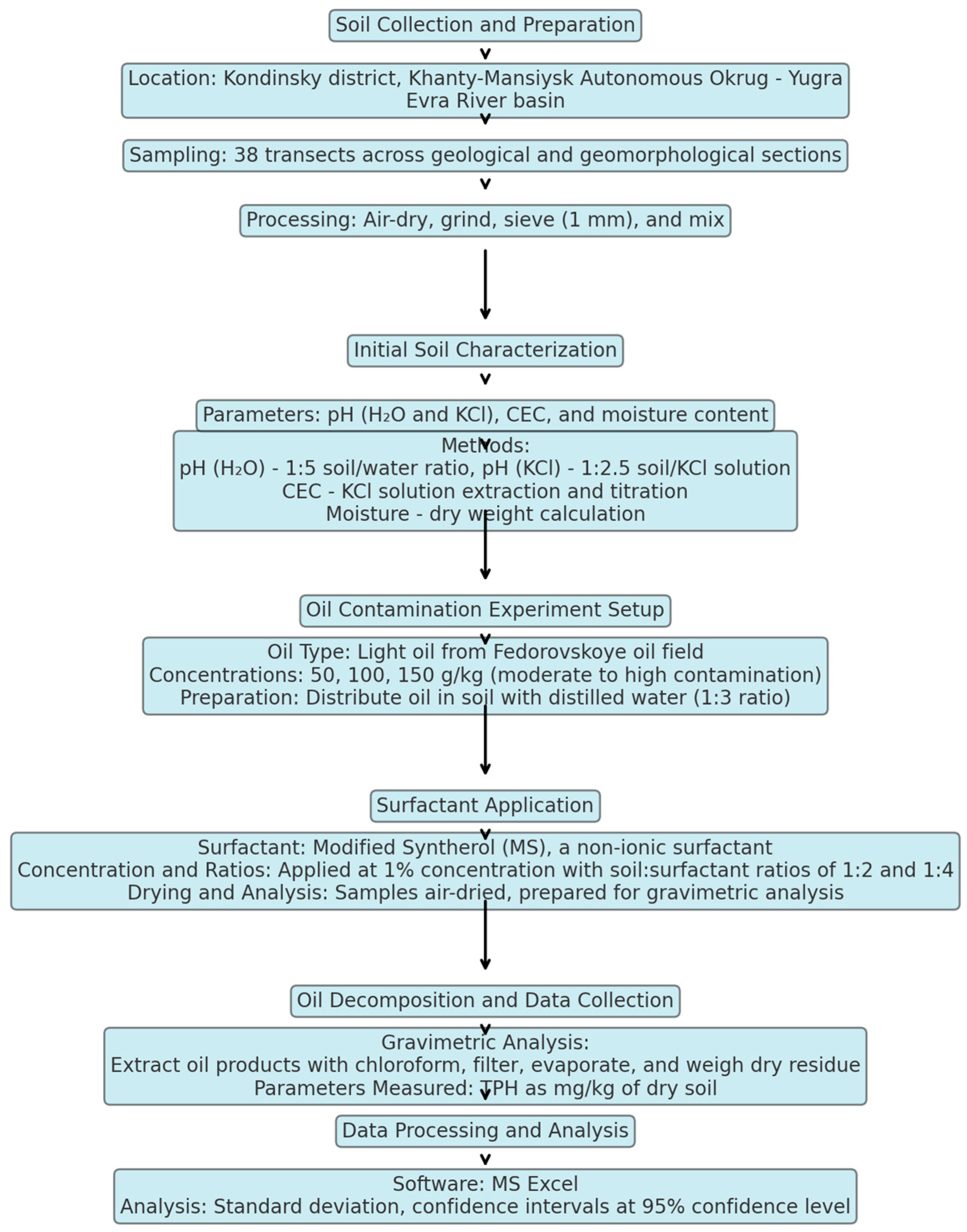
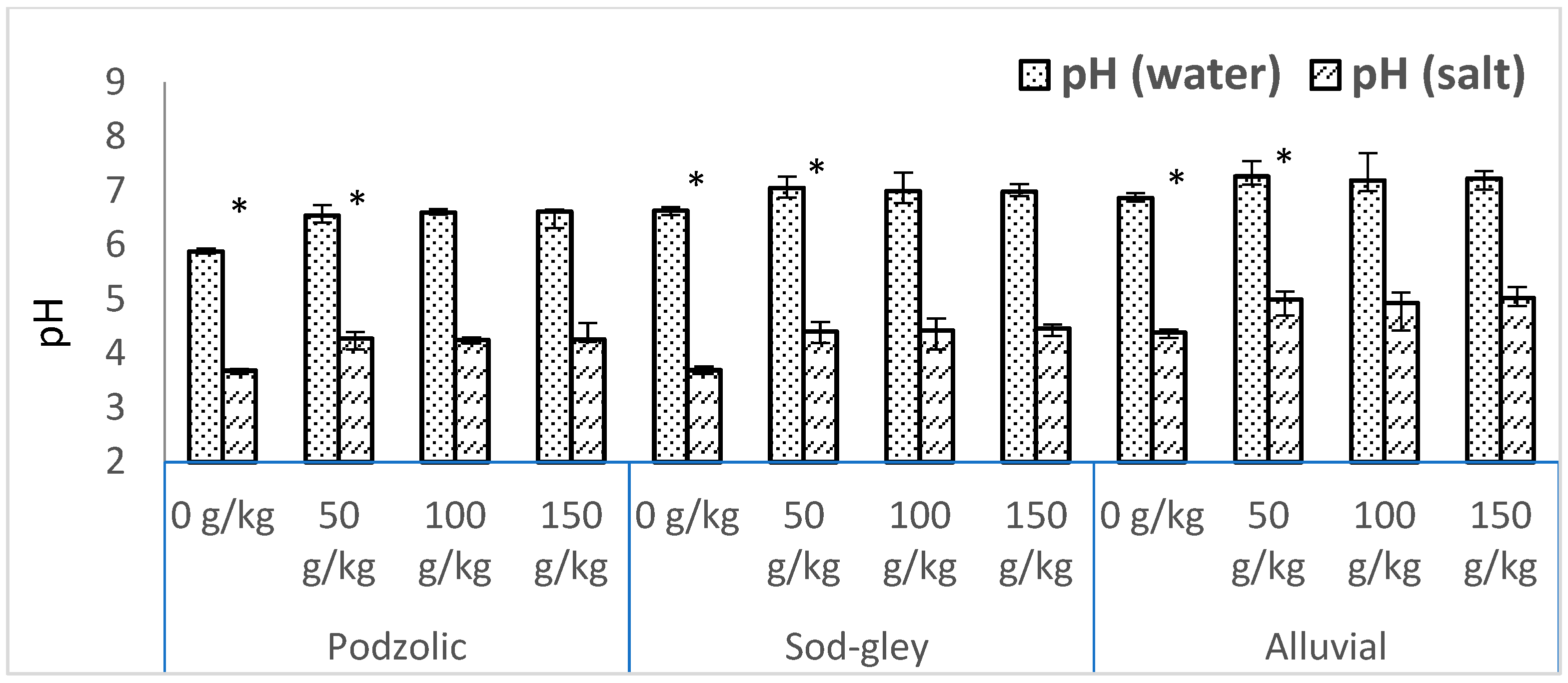
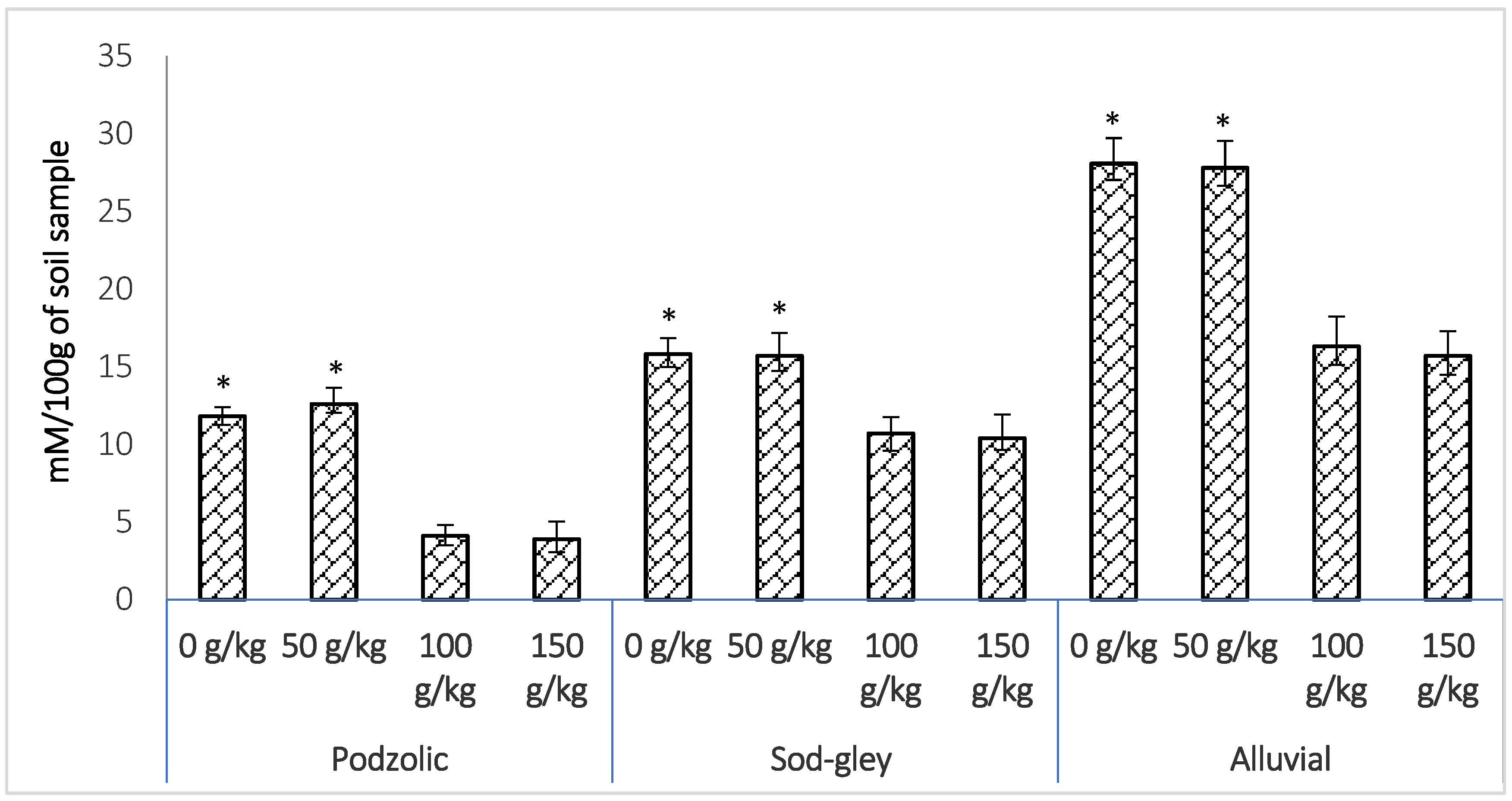
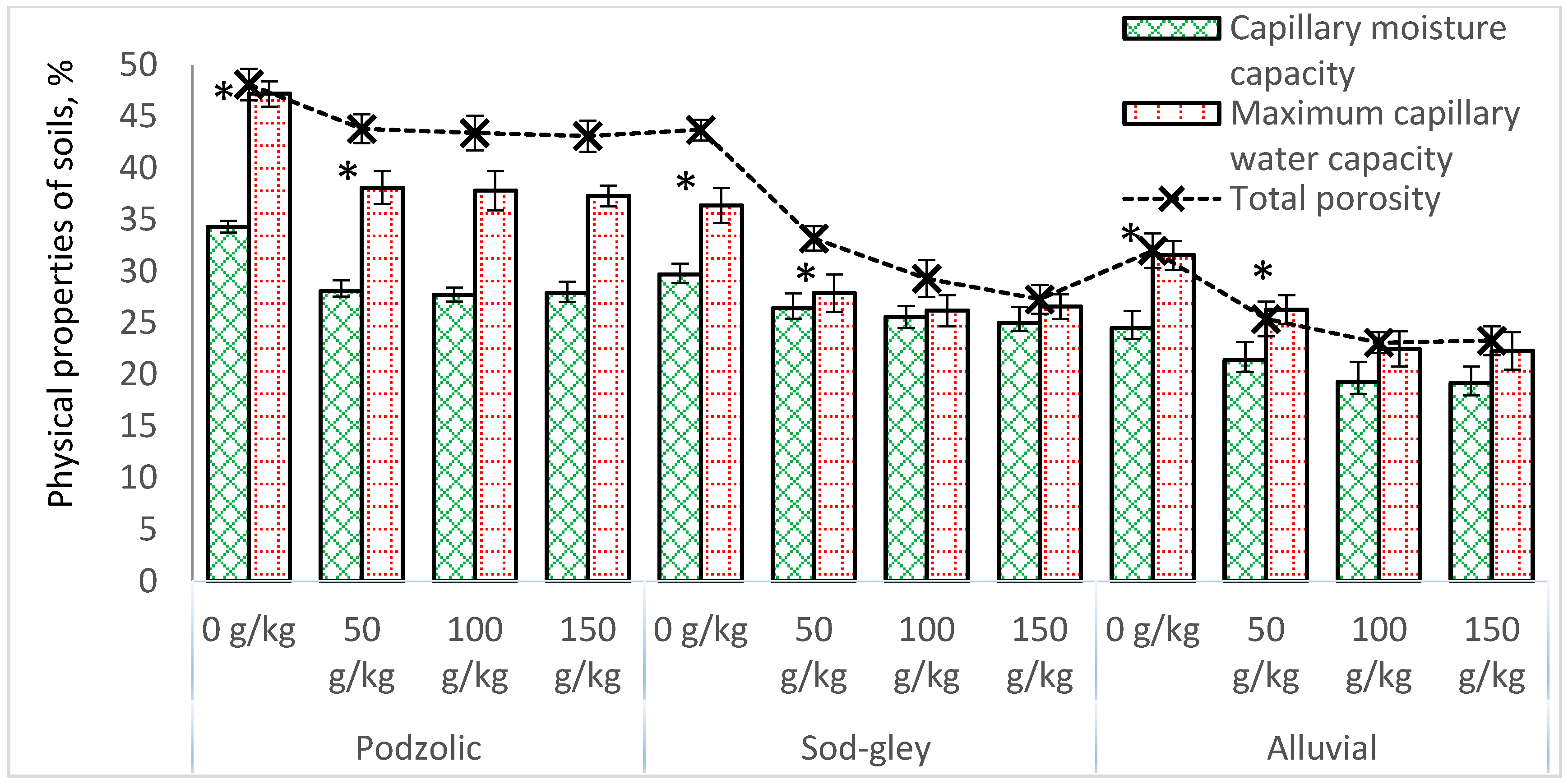
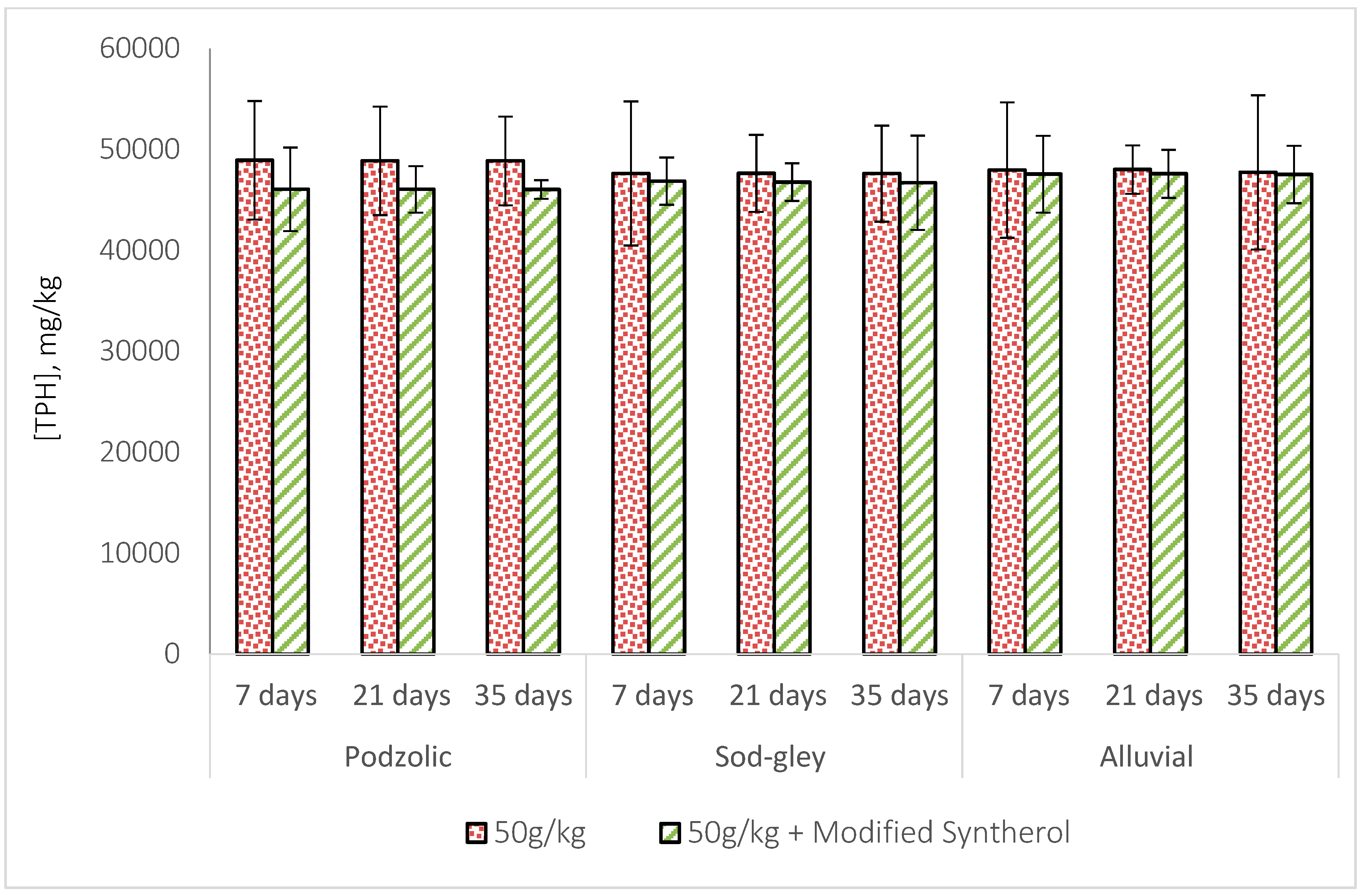
Disclaimer/Publisher’s Note: The statements, opinions and data contained in all publications are solely those of the individual author(s) and contributor(s) and not of MDPI and/or the editor(s). MDPI and/or the editor(s) disclaim responsibility for any injury to people or property resulting from any ideas, methods, instructions or products referred to in the content. |
© 2024 by the authors. Licensee MDPI, Basel, Switzerland. This article is an open access article distributed under the terms and conditions of the Creative Commons Attribution (CC BY) license (https://creativecommons.org/licenses/by/4.0/).
Share and Cite
Sutormin, O.S.; Goncharov, A.S.; Kratasyuk, V.A.; Petrova, Y.Y.; Bajbulatov, R.Y.; Yartsov, A.E.; Shpedt, A.A. Effects of Oil Contamination on Range of Soil Types in Middle Taiga of Western Siberia. Sustainability 2024, 16, 11204. https://doi.org/10.3390/su162411204
Sutormin OS, Goncharov AS, Kratasyuk VA, Petrova YY, Bajbulatov RY, Yartsov AE, Shpedt AA. Effects of Oil Contamination on Range of Soil Types in Middle Taiga of Western Siberia. Sustainability. 2024; 16(24):11204. https://doi.org/10.3390/su162411204
Chicago/Turabian StyleSutormin, Oleg S., Andrey S. Goncharov, Valentina A. Kratasyuk, Yuliya Yu. Petrova, Ruslan Ya. Bajbulatov, Aleksandr E. Yartsov, and Aleksandr A. Shpedt. 2024. "Effects of Oil Contamination on Range of Soil Types in Middle Taiga of Western Siberia" Sustainability 16, no. 24: 11204. https://doi.org/10.3390/su162411204
APA StyleSutormin, O. S., Goncharov, A. S., Kratasyuk, V. A., Petrova, Y. Y., Bajbulatov, R. Y., Yartsov, A. E., & Shpedt, A. A. (2024). Effects of Oil Contamination on Range of Soil Types in Middle Taiga of Western Siberia. Sustainability, 16(24), 11204. https://doi.org/10.3390/su162411204









